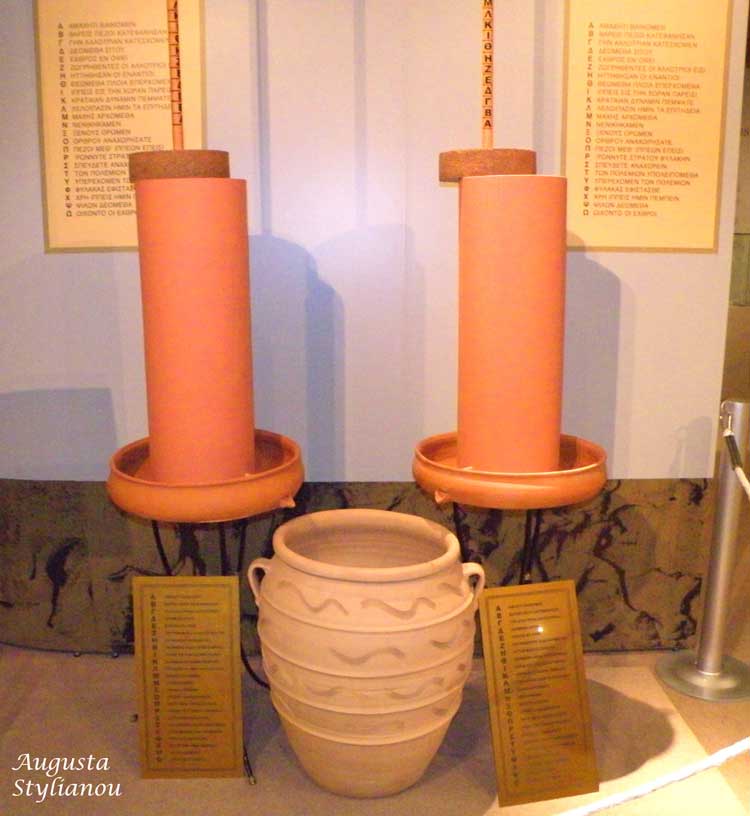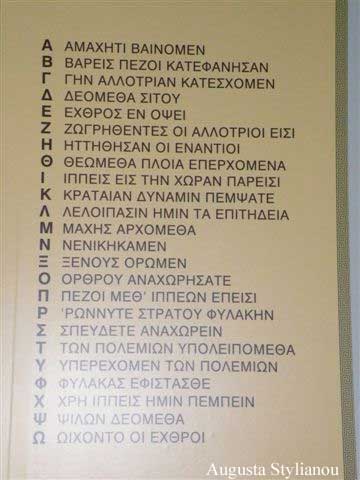.

Hydraulic telegraph of Aeneas. Photo : Augusta Stylianou Artist
The need for quick transmission of multiple and various messages led the Greeks to the astonishing conception of the hydraulic telegraph (4th century BC), a hydraulic device which required the use of only one torch fire for the transmission of predetermined messages.
Aeneas, the author of the work on strategy, withing to find a remedy for the difficulty, advanced matters a little, but his device still fell far short of our requirements, as can be seen from his description of it. He says that those who are about to communication urgent news to each other by fire signal should procure two earthenware vessels of exactly the same width and depth, the depth being some three cubits and the width one. Then they should have corks made a little narrower than the mouths of the vessels [so that the cork slides through the neck and drops easily into the vessel] and through the middle of each cork should pass a rod graduated in equal section of three finger-breadths, each clearly marked off from the next. In each section should be written the most evident and ordinary events that occur in war, e.g., on the first, "Cavalry arrived in the country," on the second "Heavy infantry," on the third "Light-armed infantry," next "Infantry and cavalry," next "Ships," next "Corn," and so on until we have entered in all the sections the chief contingencies of which, at the present time, there is a reasonable probability in wartime. Next, he tells us to bore holes in both vessels of exactly the same size, so that they allow exactly the same escape. Then we are to fill the vessels with water and put on the corks with the rods in them and allow the water to flow through the two apertures. When this is done it is evident that, the conditions being precisely similar, in proportion as the water escapes the two corks will sink and the rods will disappear into the vessels. When by experiment it is seen that the rapidity of escape is in both cases the same, the vessels are to be conveyed to the places in which both parties are to look after the signals and deposited there. Now whenever any of the contingencies written on the rods occurs he tells us to raise a torch and to wait until the corresponding party raises another. When both the torches are clearly visible the signaler is to lower his torch and at once allow the water to escape through the aperture. Whenever, as the corks sink, the contingency you wish to communicate reaches the mouth of the vessel he tells the signaler to raise his torch and the receivers of the signal are to stop the aperture at once and to note which of the messages written on the rods is at the mouth of the vessel. This will be the message delivered, if the apparatus works at the same pace in both cases. "

Hydraulic telegraph of Aeneas. Photo : Augusta Stylianou Artist
From "Ancient Greek Technology" exhibition at the Evagoras & Kathleen Lanitis Centre in Carob Mill Limassol
Replicas and Reconstruction by Prof . Kostas Kotsanas and his students
| Ancient Greece
Science, Technology , Medicine , Warfare, , Biographies , Life , Cities/Places/Maps , Arts , Literature , Philosophy ,Olympics, Mythology , History , Images Medieval Greece / Byzantine Empire Science, Technology, Arts, , Warfare , Literature, Biographies, Icons, History Modern Greece Cities, Islands, Regions, Fauna/Flora ,Biographies , History , Warfare, Science/Technology, Literature, Music , Arts , Film/Actors , Sport , Fashion --- |

